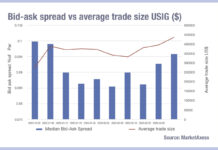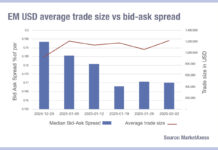Louise Drummond, global head of investment execution at abrdn, discusses the firm’s path towards workflow automation – an achievement that has been almost a year in the making, with 35% of government bonds in passive funds already no-touch and credit and equities now on the horizon.
Last summer, abrdn’s dealing desk started work on developing a new trading strategy, focusing on automating low-value trades that didn’t depend on dealer expertise. It’s the first time the firm has looked at automating trades on a no-touch basis – and so far, it’s been a great success. Drummond identified that in abrdn’s passive funds, there were a percentage of low value trades that could immediately benefit from the introduction of trade automation – and thus the journey began. “Utilising existing technology and the more advanced trading venues capabilities, those trades can get executed in a more efficient way,” explains Drummond, speaking exclusively to Global Trading. “I wanted to make better use of the data to enable the dealers to concentrate on the larger, more complex trades where they can add more value, [and] I wanted to balance the amount of time spent on a trade versus the optimal outcome.”
The beginning
In June 2023, Drummond started exploring proof-of-concept across asset classes with her team, analysing trade volumes and the type of trades to see what might fit best, and to ensure there was sufficient trading flow to make the process beneficial. They took the most suitable and liquid asset class– government bonds and explored how best to automate. “Our existing trading ecosystem had the components to support automated trading, so we leveraged that to expedite delivery – we just needed to build in some additional parameters to realise true Straight Through Processing (STP).” explains Drummond. “Now, if the trade meets the set criteria for no-touch it goes straight from the fund manager to the trading platform. The trade will need to meet the minimum number of quotes and pricing thresholds before being executed on venue.”
What took some time during the development process, of course, was the governance aspect. “We needed to ensure that we had captured the key risks and controls and discussed across the wider business, alongside monitoring this new trading protocol in our TCA to make sure we were getting optimal outcomes,” says Drummond. “ abrdn have incorporated a kill switch into the platform architecture, so that they can stop the automated trading function altogether if, for example, markets are particularly volatile.
The process
The process looks at the suitable trades and classifies them based on no-touch, low-touch, and high-touch. No-touch trades are sent straight out and executed if they meet the pre-determined criteria; if they don’t, the trade will be routed to the standard dealing blotter and the dealer will follow normal trading protocols. “It makes the whole process so much more efficient. We are reducing market latency for this population of trades which is where the real value add is. Initial observations are very positive in terms of post trade analysis” says Drummond. “That’s really what we’re monitoring. The results. You need to build that picture up over time, making sure that you’re not seeing any differences in client outcomes.”
The result
With testing in progress across the asset classes, the automated platform was launched with government bonds in early April 2024, with plans to expand into credit later in May and then equities a few months down the line. With around 35% of government bonds flow in passive funds now trading using the automated function, the process has been a success so far with robust controls and monitoring in place.
The future
abrdn has no set timeline or program for automation roll-out, which is very much based on how the flow progresses and how the initial roll-out continues to develop. “We’re also looking at some of the equity programme trades we do, to see if automation is achievable. Some programs are a bit more complex than others, but there is certainly potential there,” says Drummond. “We’re coming into a month now for results on our government automation, so we’ll continue to look at how the end-to-end process is performing and use the data to optimise the process if needed, utilising our execution oversight meetings. “It’s been a success so far,” confirms Drummond.
“We’ll continue to monitor the flow on our passive funds and decide whether to extend the workflow to actively-managed funds to see if they have any eligible orders within their trade universe that might also fit this model. “The markets are evolving, and we need to evolve with them. We’re in the infancy of automation right now, but we feel strongly there is so much more that can be done in this space. We have no set timeframe for that, we will base our decision on processes that deliver optimal outcomes for our clients.”
First posted on www.Globaltrading.net
©Markets Media Europe 2024





















